John Froelich helped feed the world — here's how an Iowa plowman fueled an agricultural revolution
The son of German immigrants, John Froelich paired a gas engine with gears and wheels to create the first tractor; it fed a growing nation and created an all-American image.
A small-town American farmboy gave the fight against food insecurity real traction.
His name was John Froelich.
And he helped feed the world in ways that Bob Geldof, Boy George and a galaxy of other celebrities connected to the holiday hit "Do They Know It's Christmas?" — including global community efforts to feed the world much, much later in the 1980s — could only imagine.
MEET THE AMERICAN WHO NEVER FLINCHED IN THE FIGHT FOR INDEPENDENCE, ABIGAIL ADAMS
All it took was American ingenuity, elbow grease — and fossil fuels.
Froelich (pronounced fray-LICK), son of German immigrants, invented the gas-powered tractor.
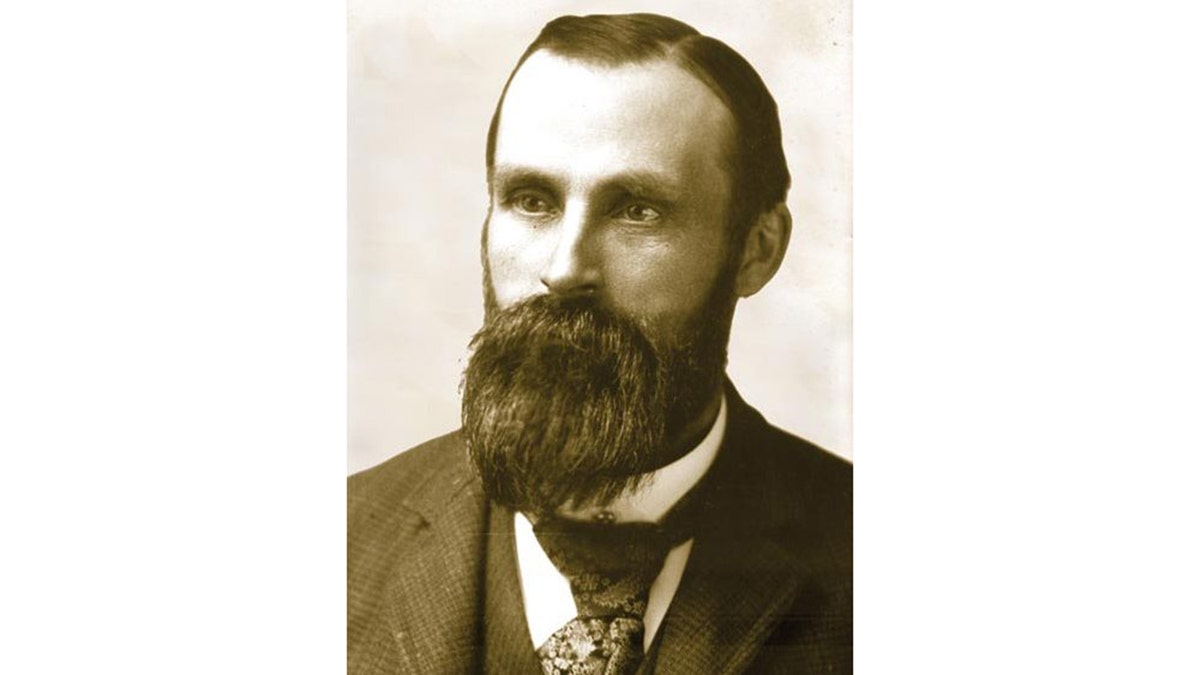
John Froelich (1849-1933) of Iowa invented the gas-powered tractor in 1892, instantly igniting a global revolution in agriculture. (Public Domain)
"He was quite an amazing man," Denise Schutte, executive director of the Froelich Foundation & Museum in Iowa, told Fox News Digital.
"He had a very creative and inventive sort of mind. He just wanted to make life better for everybody."
His gasoline traction engine, as it was first known, ignited stunning improvements in agricultural productivity.
"He had a very creative and inventive sort of mind. He just wanted to make life better for everybody."
Crops almost instantly became easier to plant and to harvest. It didn't take long for the tractor that Froelich pioneered in his Iowa grain mill to find use around the world.
Among other consequences, farmers no longer needed to devote precious land to grow food for the hungry, muscular animals that pulled their plows. Food supplies expanded dramatically, which lowered prices and availability.
Overproduction would eventually hurt small farmers. But increased efficiency and abundance helped conquer one of the great perils of humanity: starvation.
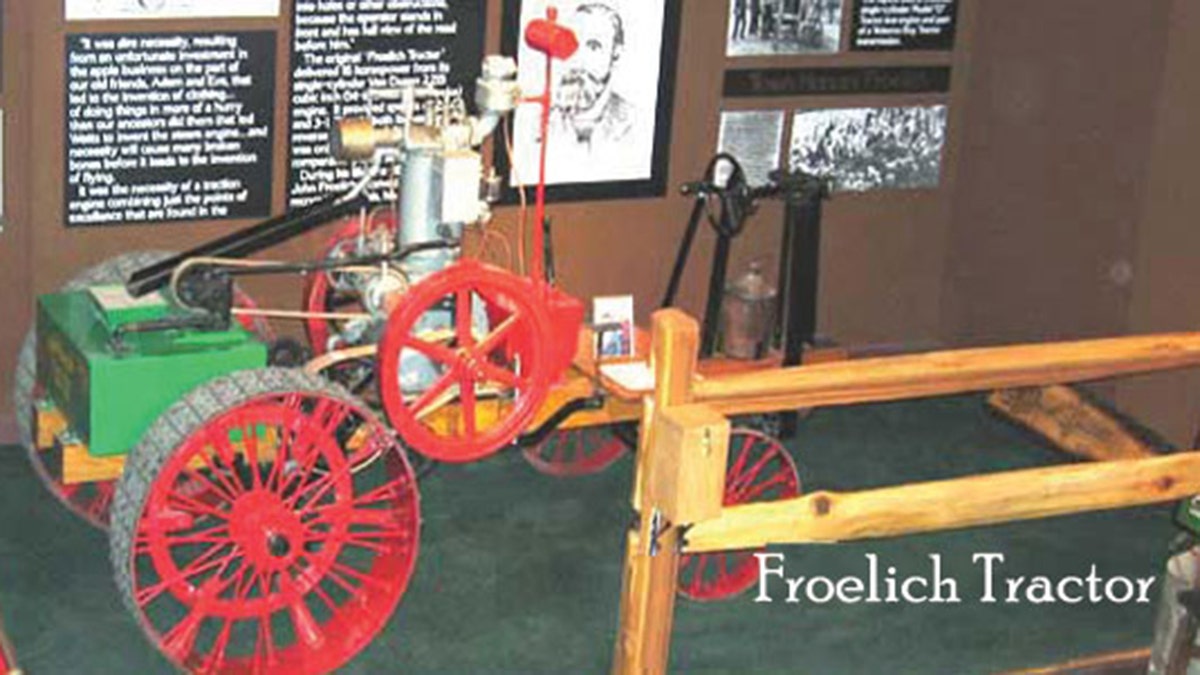
John Froelich, a grain mill operator in Iowa, inspired a revolution in agriculture when he invented the first gas-powered tractor in 1892. (Froelich Tractor Museum)
"The farm tractor was undoubtedly one of the most revolutionary technological innovations in the history of modern agriculture," UC-Davis scholars Alan L. Olmstead and Paul W. Rhode wrote in a scholarly study of tractors.
The machine was responsible for, they added, "vastly increasing the supply of farm power, raising productivity and reshaping the rural landscape."
‘Always thinking of better ways’
John Froelich was born on Nov. 24, 1849 near the village of Giard in Clayton County, Iowa.
His father, Henry Froelich, emigrated from the German state of Hesse only four years earlier. His mother, Kathryn (Gutheil), may have been born in Germany, too.
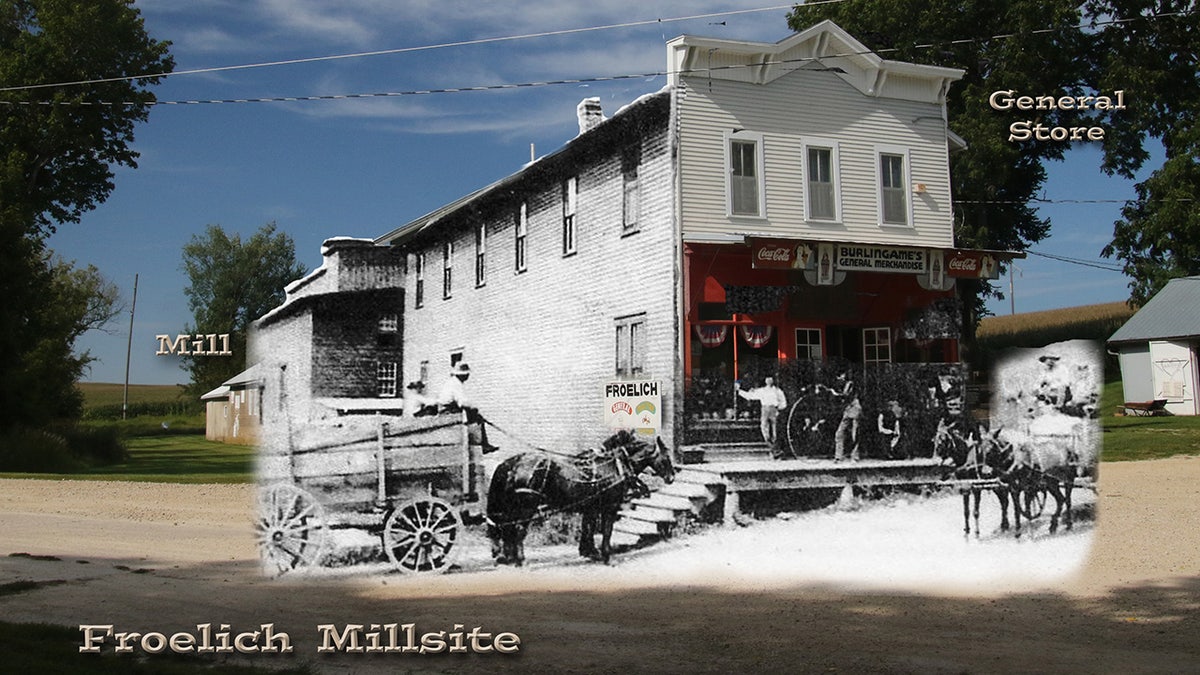
John Froelich invented the tractor in 1892 with employee William Mann in the grain elevator and mill he owned in the village of Froelich, Iowa, named for his family. (Froelich Tractor Museum)
John Froelich was the oldest of their nine children. The family suffered tragedy when their mother died two years after giving birth to the youngest child.
The family persevered through hard work and the faith of their "kind, devout" Methodist father, noted Schutte.
"I surmise that he [John] was hard working, very determined and probably very quiet," she said.
Froelich, Iowa, an unincorporated village, still appears on maps today.
Froelich had no advanced education, other than what he learned at home, in the village school on the farms, though he likely had some sort of trade school or mechanical training, said Schutte.
5 FOOD TRUCKS TO KNOW ABOUT IN 2024: ‘WONDERFUL SUPPORT’
But, she added, "his brain was always thinking of better ways to do things."
Their Froelich family's little hamlet — home to about 50 people at the time — became a train hub in the early days of railroad. It was a fortuitous coincidence of geography that helped change both local and international history.
The Froelichs lived closest to the new train station, said Schutte, so the railroads adopted the family name for the whistle stop. Froelich, Iowa, an unincorporated village, still appears on maps today.

John Froelich of Iowa tinkered with a gas-powered tractor in his home workshop and brought it to the field in 1892. It sparked a revolution in agricultural productivity. (Public Domain)
The train stop also made the village of Froelich a hub for local farmers to bring their grain. Froelich, like most Iowans, took to the fields for the harvest each summer and autumn.
"Every year at harvest time, he dragged a crew of hired hands and a heavy steam-powered thresher through Iowa and the Dakotas."
But he was also a business owner. Spurred by his love of machines and mechanics, he operated Froelich Elevator & Mill, a grain mill with a steam-powered thresher, near the train station.
The German-American entrepreneur tinkered away at the grain mill on an innovation that sparked a new era in global agriculture.
‘Detractors were silenced’
Grain — wheat, barley, corn and others — is the foundation of civilization. The human discovery that grain could be cultivated encouraged nomadic, hunter-gatherer humans to cluster around the crops they used to feed themselves.
It was the birth of agriculture. Farmers collected in villages, which grew into towns and eventually great cities. Trade, banking, business, art — civilization as we know it — grew up around grain.
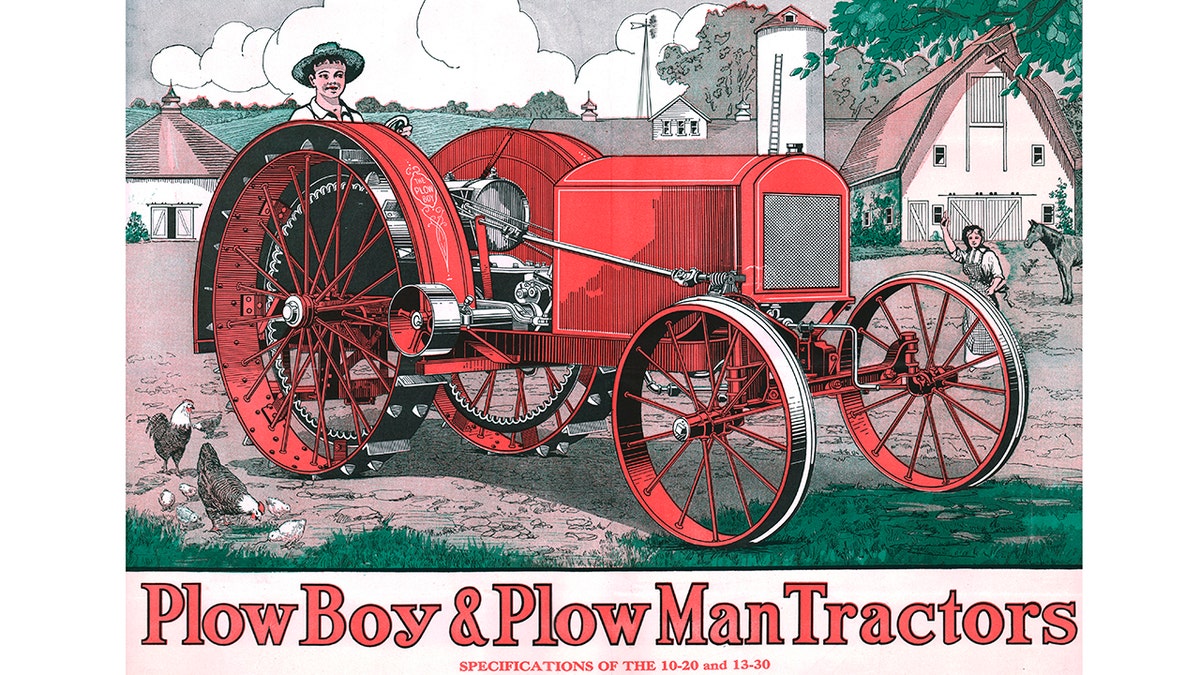
Poster for the Interstate Engine and Tractor Company, Waterloo, Iowa, in 1916. Artist unknown. (Print Collector/Getty Images)
For millennia, grain was planted, grown and harvested with the most basic tools — the hoe, scythe, grain cradle and flail — with an assist from draft animals including oxen, mules and horses.
The first major disruption came during the Industrial Revolution with the advent of steam-powered harvesters. Froelich, with his mechanical aptitude, was eager to capitalize on the new technology.
MEET THE AMERICAN WHO INVENTED SLICED BREAD: OTTO ROHWEDDER, HARD-LUCK HAWKEYE
"Every year at harvest time, he dragged a crew of hired hands and a heavy steam-powered thresher through Iowa and the Dakotas, threshing farmers’ crops for a fee," according to History.com.
The steam-powered machine was cumbersome, hard to maneuver and dangerous. The boiler was fueled by coal, wood — "just about anything they could burn," said Schutte.
The fire that was needed to power the steam engine was dangerous in a dry field of summer wheat.
"One spark from the boiler on a windy day could set the whole prairie afire," notes History.com.
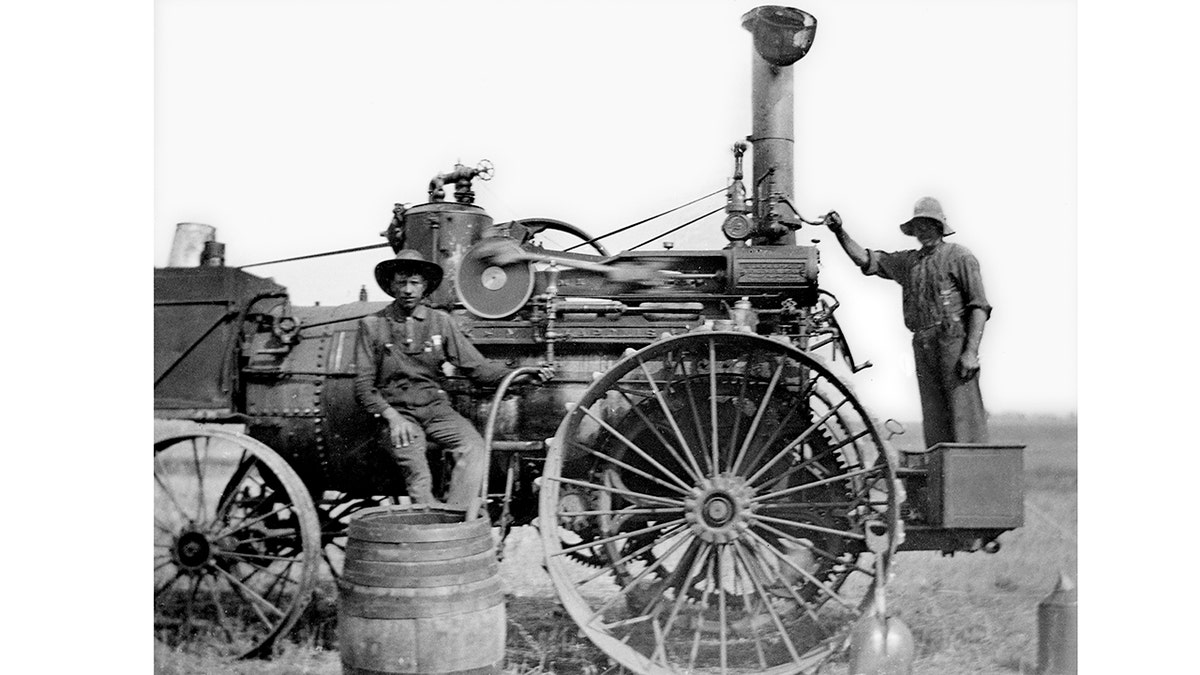
Two farmers perch on a steam tractor. One fills the radiator with water. (Kirn Vintage Stock/Corbis via Getty Images)
"John Froelich got the idea that a gasoline powered tractor would answer these problems," said Schutte.
Working with longtime employee William Mann, he mounted a single-cylinder, 16-horsepower Van Duzen gasoline engine on a wood laminate frame and, with steam-engine shafting, gears and pulleys, built by hand in an Iowa grain mill — the future of agriculture.
It was the first gas-powered tractor that could drive both forward and backward. It was actually one of the very first gas-powered vehicles of any kind.
"Froelich, his team and his gas-powered machine threshed 72,000 bushels in just 53 days."
Froelich was greeted with the same reaction felt by so many visionaries over the years. People laughed at him.
"His detractors were silenced when he successfully employed his gasoline-powered tractor in his threshing operation throughout that year's harvest season," the University of Iowa reported in its biography of the farm-state icon.
Froelich proved them wrong in a field in Langford, South Dakota during the 1892 wheat harvest.
"A man with a flail could thresh about 7 bushels (420 pounds) of wheat a day," reports the website of Living History Farms in Urbandale, Iowa.
Froelich, his team and his gas-powered machine threshed 72,000 bushels in just 53 days. That's nearly 1,400 bushels per day.
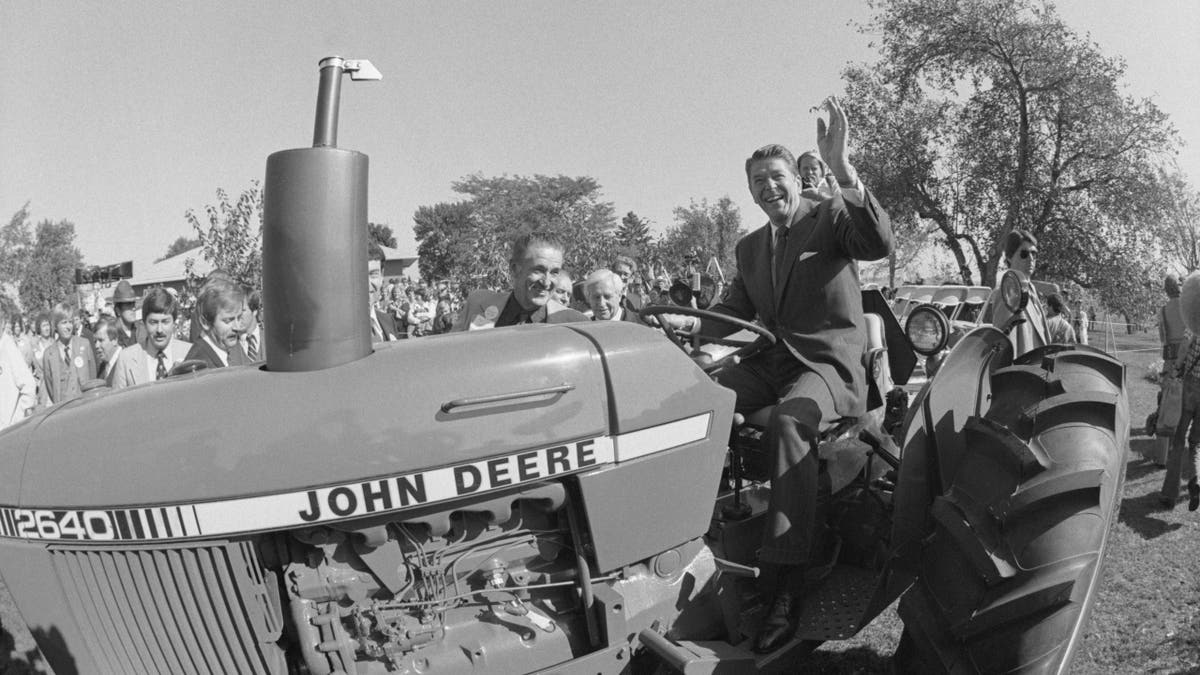
Republican presidential candidate Ronald Reagan is shown behind the wheel of a tractor during a visit to the farm of Robert Lounsberry, the state of Iowa's agriculture secretary, shown just behind the tractor's engine. (Getty Images)
Spurred by its success, Froelich founded the Waterloo Traction Engine Co. in 1893 in Waterloo, Iowa.
He left the company only two years later — but planted the seeds of a rich harvest of innovation in agriculture.
Fueled by gas and diesel instead of steam, mechanized farming expanded rapidly.
Froelich's gasoline traction engine earned its now-popular and iconic name in 1906, when farm-equipment manufacturer Hart-Parr Co. ran advertisements promoting its products by combining the words traction and motor.
The word tractor was an instant hit. But not everyone was sold right away on the tractor business.
MEET THE AMERICAN WHO CREATED TIME ZONES, CHARLES F. DOWD, SCHOOLMASTER SET CLOCK FOR MANKIND
One doubtful Illinois farm-equipment company looked at the tractor and "thought maybe this is the way to go, but maybe not," said Schutte.
"The company was already known for wonderful plows and different farm implements that were pulled behind horses."
The company founded by John Deere overcame its doubts and purchased Waterloo Gasoline Engine Co. — the tractor company Froelich founded — for $2.1 million in 1918.
‘He really did feed the world’
John Froelich died on May 24, 1933, in St. Paul, Minnesota. He was 83 years old.
After leaving his equipment company in the 1890s, "he relocated first to Dubuque, before settling in St. Paul, Minnesota, where he worked as a financial adviser," the University of Iowa noted.

Plowing prairie soil with tractor, South Dakota, Magic Lantern Slide, circa 1910. (Universal History Archive/Universal Images Group via Getty Images)
"He had four children with his wife, Kathryn Bickel, and died in relative obscurity. Despite his passion for invention, he appears to have made little future contribution to agricultural machinery innovations."
In addition to its unfathomable contributions to agriculture and food productivity, the gasoline traction engine born in an Iowa grain mill is symbolic of the nation’s work ethic and agricultural productivity.
CLICK HERE TO SIGN UP FOR OUR LIFESTYLE NEWSLETTER
American farmers rely on tractors to harvest a third of the entire world’s corn crop, to cite just one example. American corn feeds both humans and livestock and has a variety of industrial uses.
Tractors play a central role in American pop culture and politics, too.

Singer-songwriter Jason Aldean poses during the celebration of his song "Big Green Tractor" reaching No. 1 on the country music charts, Sept. 29, 2009 in Nashville, Tennessee. (Rick Diamond/Getty Images for BMI)
"She Thinks My Tractor’s Sexy," country singer Kenny Chesney crooned in his 1999 concert sing-along hit; Jason Aldean rode to the top of the country charts with "My Big Green Tractor" in 2009.
Ronald Reagan made tractors a part of his everyman image. He rode them in photo ops while governor of California in the 1960s.
And he famously drove a tractor across the Illinois farm of the Werries family in 1982 to celebrate lifting the grain embargo on the Soviet Union imposed by the Carter administration.
Froelich’s legacy is kept alive today at the Froelich Tractor Museum in the Iowa village that bears his family’s name.
"It was once a thriving community that boasted of a depot, sawmill, blacksmith shop, a creamery, a post office (still in the general store), a hatchery, stockyards, ice house, barber shop, shipping warehouse and church," the museum notes on its website.

John Froelich invented the gas-powered tractor in Iowa in 1892.
The Froelich Tractor Museum opens for the 2024 season on May 11.
It attracts curious and grateful visitors from around the world — including as far away as Australia.
CLICK HERE TO GET THE FOX NEWS APP
"It's hard to put into words the impact of Froelich's tractor," said Schutte.
"He built a machine that made life easier and food more abundant for people around the world. He did it right here in our little corner of Iowa. Froelich really did feed the world."
To read more stories in this unique "Meet the American Who…" series from Fox News Digital, click here.
For more Lifestyle articles, visit www.foxnews.com/lifestyle.


